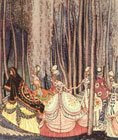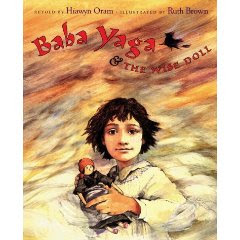
According to the jacket blurb, this is "an eerie and haunting tale about the subtle but persistent struggle between the two sides of ourselves, and the heroic strength it takes to claim a victory." The reteller, Laura Amy Schlitz, says "I went in search of a story that would tell students that no matter how bad things get, you hold on."
Now, in case you're not familiar with it, the original Grimm story is a bit different than this retelling. In the original, a soldier comes home from the wars with no skills of use. His brothers kick him out, and he wanders off, finally sitting down on a hill and resigning himself to starvation. The devil appears and offers him a bargain - if he wears the skin of a bear he's just shot, doesn't bathe or cut his hair for seven years, and won't say the Lord's Prayer, he'll be rich the rest of his life. If he breaks the deal, he belongs to the devil. The soldier agrees, and off he goes. Of course, after a few years he's a filthy monster, but people tolerate him because of his wealth. One night, he meets an old man in an inn. The man's fortune has declined and he's impoverished. Bearskin pays his debts and the man offers him one of his daughters in marriage in exchange. The two older girls are horrified, but the youngest agrees to honor her father's promise. For three more years, Bearskin roams the world, doing good and asking people to pray for him. He wins his bargain and returns wealthy (and clean). The two older girls don't recognize him and are all over him now - but he spurns them and takes the faithful youngest daughter. The two older girls commit suicide, and the devil takes their souls.
In this retelling, the soldier returns from war to devastation. His family is gone and he has no hope. After he agrees to the devil's bargain (which cuts him off from all prayer), he cycles deeper and deeper into despair, until one day he helps a beggar and she prays for him. He realizes there is hope yet, and he begins to use his wealth to help others, asking them to pray for him. Eventually, he pays the debts of a gambler, who promises one of his daughters. The middle daughter says she believes Bearskin has a "good heart" and promises to be his wife. After Bearskin wins his bargain, he returns and claims his faithful bride.
The artwork is dark and filled with half-seen patterns and the pages around the text have a look of parchment. Each illustration is done in shades of black, gray, and brown, with the devil's green coat and the yellow and white butterflies, representing the prayers of the poor, the only lighter colors. The spread showing the cleansed Bearskin greeting his bride is in warm golden-browns and the final page shows the raging devil in black and greens.
I differ a bit in my view of this little-known Grimm story from both the blurb and the author. The original tale isn't especially strong on morals, except for not judging by appearances. However, in this retelling, I see a story of redemption. The soldier is without hope or family and has no reason to live when he accepts a deal with the devil. However, as he sinks deeper and deeper into a morass of despair, he discovers hope. Eventually, he is reborn through the removal of his filthy coat, showing the kind and generous person he has become underneath. I guess it still has a "don't judge by appearances" moral too.
Verdict: This isn't a casual read for younger children, but a story for discussion and re-reading with an older group.
ISBN: 978-0763627300; Published October 2007 by Candlewick; Borrowed from the library; Added to my personal wishlist












